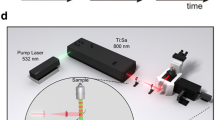Abstract
Fluorescence-based methods are widely used to detect crossing of peptides across model or biological membranes. For membrane-active peptides, i.e., peptides that have strong membrane tropism, fluorescence experiments must be accompanied by relevant controls, otherwise they can lead to inconsistent interpretation and underestimation of their limitations. Here we describe how to prepare samples to study fluorescent peptide crossing droplet interface bilayer (model membrane) or cell membrane (biological membrane) and the pitfalls that can affect observational qualitative and quantitative data.
Access this chapter
Tax calculation will be finalised at checkout
Purchases are for personal use only
Similar content being viewed by others
References
Jiao C-Y, Delaroche D, Burlina F, Alves ID, Chassaing G, Sagan S (2009) Translocation and endocytosis for cell-penetrating peptide internalization. J Biol Chem 284:33957–33965
Walrant A, Cardon S, Burlina F, Sagan S (2017) Membrane crossing and Membranotropic activity of cell-penetrating peptides: dangerous liaisons? Acc Chem Res 50:2968–2975
Illien F, Rodriguez N, Amoura M, Joliot A, Pallerla M, Cribier S, Burlina F, Sagan S (2016) Quantitative fluorescence spectroscopy and flow cytometry analyses of cell-penetrating peptides internalization pathways: optimization, pitfalls, comparison with mass spectrometry quantification. Sci Rep 6:36938
Richard JP, Melikov K, Vives E, Ramos C, Verbeure B, Gait MJ, Chernomordik LV, Lebleu B (2003) Cell-penetrating peptides. A reevaluation of the mechanism of cellular uptake. J Biol Chem 278:585–590
Derossi D, Joliot AH, Chassaing G, Prochiantz A (1994) The third helix of the Antennapedia homeodomain translocates through biological membranes. J Biol Chem 269:10444–10450
Drin G, Cottin S, Blanc E, Rees AR, Temsamani J (2003) Studies on the internalization mechanism of cationic cell-penetrating peptides. J Biol Chem 278:31192–31201
Swiecicki J-M, Bartsch A, Tailhades J, Di Pisa M, Heller B, Chassaing G, Mansuy C, Burlina F, Lavielle S (2014) The efficacies of cell-penetrating peptides in accumulating in large unilamellar vesicles depend on their ability to form inverted micelles. Chembiochem 15:884–891
Terrone D, Sang SLW, Roudaia L, Silvius JR (2003) Penetratin and related cell-penetrating cationic peptides can translocate across lipid bilayers in the presence of a transbilayer potential. Biochemistry 42:13787–13799
Bárány-Wallje E, Keller S, Serowy S, Geibel S, Pohl P, Bienert M, Dathe M (2005) A critical reassessment of penetratin translocation across lipid membranes. Biophys J 89:2513–2521
Moghal MMR, Islam MZ, Sharmin S, Levadnyy V, Moniruzzaman M, Yamazaki M (2018) Continuous detection of entry of cell-penetrating peptide transportan 10 into single vesicles. Chem Phys Lipids 212:120–129
Persson D, Thorén PEG, Herner M, Lincoln P, Nordén B (2003) Application of a novel analysis to measure the binding of the membrane-translocating peptide penetratin to negatively charged liposomes. Biochemistry 42:421–429
Walrant A, Matheron L, Cribier S, Chaignepain S, Jobin M-L, Sagan S, Alves ID (2013) Direct translocation of cell-penetrating peptides in liposomes: a combined mass spectrometry quantification and fluorescence detection study. Anal Biochem 438:1–10
Säälik P, Niinep A, Pae J, Hansen M, Lubenets D, Langel Ü, Pooga M (2011) Penetration without cells: membrane translocation of cell-penetrating peptides in the model giant plasma membrane vesicles. J Control Release 153:117–125
Gehan P, Kulifaj S, Soule P, Bodin JB, Amoura M, Walrant A, Sagan S, Thiam AR, Ngo K, Vivier V, Cribier S, Rodriguez N (2020) Penetratin translocation mechanism through asymmetric droplet interface bilayers. Biochim Biophys Acta Biomembr 1862:183415
Patel LN, Zaro JL, Shen W-C (2007) Cell penetrating peptides: intracellular pathways and pharmaceutical perspectives. Pharm Res 24:1977–1992
Birch D, Christensen MV, Staerk D, Franzyk H, Nielsen HM (2017) Fluorophore labeling of a cell-penetrating peptide induces differential effects on its cellular distribution and affects cell viability. Biochim Biophys Acta Biomembr 1859:2483–2494
Cavaco M, Pérez-Peinado C, Valle J, Silva RDM, Correia JDG, Andreu D, Castanho MARB, Neves V (2020) To what extent do fluorophores bias the biological activity of peptides? A practical approach using membrane-active peptides as models. Front Bioeng Biotechnol 8:552035
Hedegaard SF, Derbas MS, Lind TK et al (2018) Fluorophore labeling of a cell-penetrating peptide significantly alters the mode and degree of biomembrane interaction. Sci Rep 8:6327
Burlina F, Sagan S, Bolbach G, Chassaing G (2005) Quantification of the cellular uptake of cell-penetrating peptides by MALDI-TOF mass spectrometry. Angew Chem Int Ed Engl 44:4244–4247
Seisel Q, Pelletier F, Deshayes S, Boisguerin P (2019) How to evaluate the cellular uptake of CPPs with fluorescence techniques: dissecting methodological pitfalls associated to tryptophan-rich peptides. Biochim Biophys Acta Biomembr 1861:1533–1545
Vasconcelos L, Lehto T, Madani F, Radoi V, Hällbrink M, Vukojević V, Langel Ü (2018) Simultaneous membrane interaction of amphipathic peptide monomers, self-aggregates and cargo complexes detected by fluorescence correlation spectroscopy. Biochim Biophys Acta Biomembr 1860:491–504
Vercauteren D, Vandenbroucke RE, Jones AT, Rejman J, Demeester J, De Smedt SC, Sanders NN, Braeckmans K (2010) The use of inhibitors to study endocytic pathways of gene carriers: optimization and pitfalls. Mol Ther 18:561–569
Author information
Authors and Affiliations
Corresponding author
Editor information
Editors and Affiliations
Rights and permissions
Copyright information
© 2022 The Author(s), under exclusive license to Springer Science+Business Media, LLC, part of Springer Nature
About this protocol
Cite this protocol
Walrant, A., Illien, F., Sagan, S., Rodriguez, N. (2022). Challenges and Methods for the Study of CPP Translocation Mechanisms. In: Langel, Ü. (eds) Cell Penetrating Peptides. Methods in Molecular Biology, vol 2383. Humana, New York, NY. https://doi.org/10.1007/978-1-0716-1752-6_9
Download citation
DOI: https://doi.org/10.1007/978-1-0716-1752-6_9
Published:
Publisher Name: Humana, New York, NY
Print ISBN: 978-1-0716-1751-9
Online ISBN: 978-1-0716-1752-6
eBook Packages: Springer Protocols



